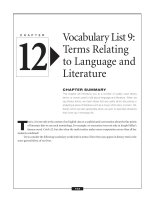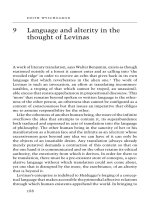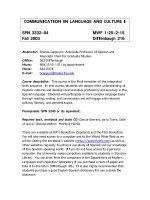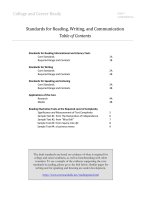L10 2 HW language and communication
Bạn đang xem bản rút gọn của tài liệu. Xem và tải ngay bản đầy đủ của tài liệu tại đây (104.29 KB, 11 trang )
LISTENING
UNIT 8: LANGUAGE & COMMUNICATION
MINO RITY LANG UA GES 1
Listen to the first part of the lecture and answer the questions. Choose the correct
letter, A, B or C.
1. Which area represents the languages the lecturer will concentrate on?
2. Which chart represents the number of speakers of Breton?
Trg1
3. Which char represents the number of peakers of Manx?
MINO RITY LANG UA GES 2
Listen and complete questions 4-10
Complete the table below
Write NO MORE THAN THREE WORDS AND/OR A NUMBER for each answer
Cornish
Decline
Rapid decline
since peak in
4………………….
Revival
- Started early
20th century
- Publications,
films and music
Official status
Recognized as
UK
5………………….
in 2002
UNESCO status
Critically
endangered
language
(revitalized)
Manx
6…………………
died in 1974
Breton
Large decrease
in numbers in
8…………….. of
20th century
- Taught in
some schools
- Taught as
second
language in
schools
7………………..
on island
- Radio
broadcasts in
Manx
- Breton
languagemedium
schools
- Large body of
literature and
media
Recognized as
Isle of Man’s
official language
in 1985
Critically
endangered
(revitalized)
9…………….......
as official
language due to
French
Constitution
10………………...
A MODERN FO RM OF COM MUNICATI ON 1
Questions 31-37
Choose the correct letter, A, B or C
31. Which pie chart shows the percentage of the people who make a phone call
every day?
A
B
47
%
C
53
%
92
%
32. Which pie chart shows the percentage of young people who text every day?
A
B
C
Trg3
15
%
90
%
65
%
33. On average men
A. send fewer texts than women
B. send shorter texts than women
C. have fewer contacts than women
34. Originally, text messaging was created as
A. an internal messaging system
B. a new commercial venture for a mobile phone company
C. a way of sending greetings to friends and family
35. Early texters were limited by
A. incompatibility between mobile phone networks
B. unsophisticated mobile phones
C. expensive mobile phones
36. Abbreviated texting language
A. is unpopular with many people
B. was created due to limitations in text length
C. has caused children’s language skills to decline
37. On average, children who text
A. have better speaking skills than those who don’t
B. have better reading and writing skills than those who don’t
C. do not show any difference in their language skills
A MODERN FO RM OF COM MUNICATI ON 2
Questions 38-40
Choose THREE letters A-G
Which three uses of text messaging were mentioned in the survey?
C. buying an airline ticket
D. following a package delivery
E. making a doctor’s appointment
F. making a donation
G. voting in an election
SOCIOLOGY RESE ARCH P ROJE
CT SURVE Y
Questions 1-5
Write NO MORE THAN THREE WORDS
AND/OR A NUMBER for each answer
A
g
e
:
SOCIOLOGY
RESEARCH
PROJECT SURVEY
1
P
o
s
t
c
o
d
e
:
2
C
O
M
P
U
T
E
R
F
Trg5
...
A
C
I
L
I
T
I
E
S
W
h
e
r
e
?
3
S
P
O
R
T
S
F
A
C
I
L
I
T
I
E
S
A
L
R
E
A
D
Y
U
S
E
D
W
h
e
r
e
4
E
D
U
C
A
T
I
O
N
F
A
C
I
L
I
T
I
E
S
A
L
R
E
A
D
Y
U
S
E
D
W
h
e
r
Trg6
...
e
?
improvement
made?
1
0
5
a
w
e
e
k
Questions 6-10
Complete the form below
Write NO MORE THAN THREE
WORDS AND/OR A NUMBER
for each answer
LANGUAGE MATTERS
IMPROVEMENTS FOR
THE COMMUITY CENTRE
New
sports:
6
and
.
Classe
s
organi
zed
only
for:
7
.
Educati
on
classes:
8
and
. Willing
to pay
about
9£
for new
classes
Possible
frequen
cy of
visits, if
Trg7
Listen again and complete the sentences. Use no more than two words for each
answer.
1.
2.
3.
4.
The language of Kasabe was discovered by a
.
It is not
for languages to become extinct.
Languages are disappearing at a faster
now than in the past.
Cornish and Manx can be classified as
languages.
THE W ELSH LANGUAGE A ND W ELSH NAMES
Questions 1-5
Choose the correct letter A, B or C.
1. How many people speak Welsh language in North and West Wales?
A. 16%
B. 20%
C. 50%
2. The Welsh Language Act of 1967 said that all official documents should be
A. In both Scots and Welsh
B. In both English and Welsh
C. In only Welsh
3. When has there been increased interest in Welsh?
A. Since the 1960s
B. Since the 1970s
C. Since the 1980s
4. Where do people learn Welsh as a first or second language?
A. In primary schools
B. In secondary schools
C. In universities
5. Which TV channel broadcasting is mainly in Welsh?
A. An independent fourth TV channel
B. BBC TWO
C. The independent Broadcasting Authority
Questions 6-10
6. Many English surnames were originally connected with a
Normans arrived.
before the
7. Jack Long and Mary Little are surnames that were connected with
8. Some English surnames were originally connected with a
9. The most common Welsh surnames were all originally
some form.
10. Welshmen living in England are often called by the
.
.
names in
“Taffy”.
DIFFE RENCES BETW EEN BRITISH ENGLISH AND A MERI CAN ENGLIS H
Questions 1-10
NO MORE THAN TWO WORDS
1. Americans and the British use a lot of the same words, but they
differently.
2. Americans have different_
in different regions.
3.
has an effect on language too.
4. In British English, a motorway is in American English a
5. In British English, a fortnight is in American English
6. In British English, pants means
.
7. The American spelling is closest to its_
ancestor.
8. In American English, colour is spelled
.
9. Realize is spelled by
people.
10. Traveler is spelled by the
.
them
.
.
HISTORY O F THE ENGLI SH LANG UA GE (PART 1)
Questions 1-7
NO MORE THAN THREE WORDS
1. The Angles and Saxons came from
and the Jutes from Jutland.
2. A mix of their languages produced a language called Anglo-Saxon or
.
3. Three more invasions added words to Old English. They were the Viking of Denmark,
and Sweden.
4. Norman forces from the
led by a man known as William the
Conqueror invaded.
5. Middle English still sounds similar to
, and it also begins to sound like
Modern English.
6.
people from different countries could communicate using Latin.
7. During the Renaissance, there was renewed interest in ancient
texts.
Questions 8-12
NO MORE THAN THREE WORDS AND/OR A NUMBER
Questions
Answers
8. What language had a great effect on the English language?
9. When did William Caxton return to Britain?
10. What did William Caxton bring back with him when
he returned to Britain?
11. What did the printing press make it possible for
almost everyone?
12. What dialect was the standardization based on?
HISTORY O F THE ENGLI SH LANG UA GE (PART 2)
Questions 1-3
NO MORE THAN TWO WORDS AND/OR A NUMBER
1. English speakers can communicate with English speakers in the last part
of
century.
2. William Shakespeare,
writer, played an important role in the English
language developed at that time.
3. Shakespeare’s works provide feelings of anger,
and laughter.
Questions 4-8
4. Which Shakespeare’s play makes people cry when they see it?
A. A Midsummer Night’s Dream
B. Romeo and Juliet
C. Julius Caesar
5. What happened to the English language nine years before the death of William
Shakespeare?
A. It took a big step.
B. It developed slowly.
C. It stopped developing for some time.
6. What was the name of the first small colony?
A. James
B. Jacksontown
C. Jamestown
7. Where are the names of many great rivers in the United States taken from?
A. English words
B. Indian words
C. American Indian words
8. How does English expand the language?
A. by changing foreign words to English
B. by borrowing or adding foreign words to English
C. by borrowing or adding English to foreign words
Question 9-10
Where do these words come from?
Choose a letter (letters) from A-F to answer the questions.
A.
B.
C.
D.
E.
F.
the Mississippi
shampoo
motel
the Missouri
banana
hotel
American Indian words
Answers
Example:
India
9.
Africa
10.
A,D
Questions 11-12
NO MORE THAN THREE WORDS OR A NUMBER
11. How do English speakers continue to invent new words?
12. How many words are there in the Oxford English Dictionary?









